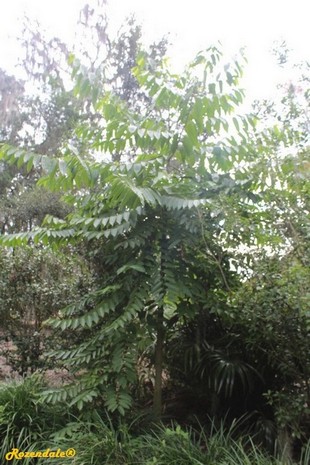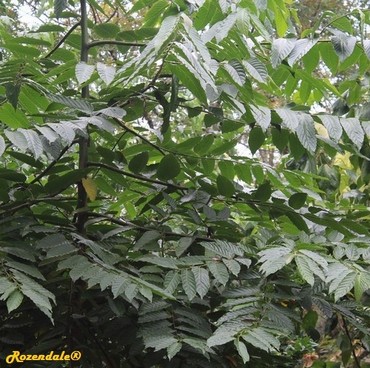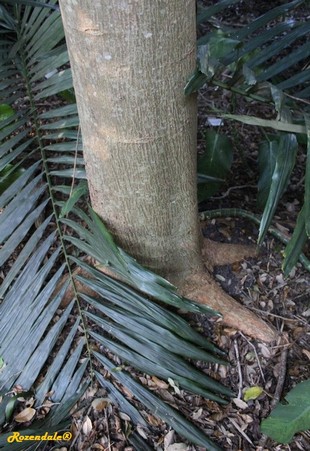Sidebar
Cananga odorata - Ylang Ylang
Description and Uses
Cananga odorata (Ylang Ylang) is a tropical tree from South East Asia . It is mainly grown for its oil crops , which have a long shelf life. The crop is harvested by hand picking. It starts flowering after 2 - 5 years. The yield will be 6 kg flowers/tree/year, but in its top season there will be a yield of 10 kg flowers/tree/year. Other crop types include; timber, ornamental, oil, fuel, cosmetics, . The flower is used as spice . The flower is used as " high vitamin-C content, no medical uses, UV protection, " with Caryophyllene (3.1%/oil - 10.7%/oil) as its significant phytochemical. There is ylang ylang oil extracted by steam distillation from the tree's fresh leaf yielding 1.00%/flow - 2.25%/flow oil. The tree's wood is called ylang ylang firewood and has a density of 280 - 300 kg/m³. Regarding firewood production the tree's growing speed is fast, it's energetic value is 4200 ckal/kg and the wood's drying speed is slow. After 14 years the tree can be totally removed as it reached its commercial and ecological goal. Cananga odorata has a lifespan of 60 years.
Environmental limitations
The tree is
38 meters tall with a crown of
25 meters wide. The
tree prefers a planting distance of
600 cm and a row distance of
600 cm. It is
very fast growing and
intolerant to shade.
Cananga odorata has a
deep root-system and it has symbiotic associations with the
fungi
(endo-mycorrhiza). It is
not able to fix nitrogen with
"any bacteria. The name(s) or string of bacteria include(s)
"not applicable ". The
tree's flower-morphology is
hermaphroditic and is pollinated by
moths.
Cananga odorata is
evergreen and
not allelopathic and has
no thorns.
Cananga odorata thrives in an altitude of
0 to
1800 meters above sea-level
(tropical). The minimum temperature is
2°C; optimally between
20 -
27°C. The optimal rainfall is
2650
mm/year. Without irrigation the annual rainfall should be between
650 -
4000mm (L/m²). The optimal soil-pH is between
5.0 -
8.0 in a soil texture of
sand. To salt it is
a bit tolerant to wind
tolerant and to fire
intolerant.
Pests and Diseases
Cananga odorata is susceptible to the following pests: . And it's susceptible to the following diseases: (missing data) , , .
Seed Propagation
Seeds are orthodox and can be stored for 9 months. There are approximative 11000 seeds/kg. The seeds can be propagated as followed:
- (1) Store harvested seeds dry at room temperature
- (2) Soak the seeds overnight in warm water before sowing.
- (3) Remove the seeds from cold to a permanent warm temperature.
| Vertical Photo [+] |

|
Harry P Leu, Orlando, United States - 2016-11-14 |
| Seeds Photo [+] [Buy Seeds] |

|
Rijs, Netherlands - 2019-12-10 |
| Detail Photo [+] [Mother Plants] |

|
Harry P Leu Gardens, United States - 2016-11-15 |
| Seedling Photo [+] [Buy Seedlings] |

|
Roodeplaat, South Africa - 2019-12-11 |
| Stem Photo [+] |

|
Coral Gables, United States - 2016-11-20 |
| [Crops Photos] [+] [Buy Crops] |

|
Holon, Israel - 2019-12-12 |
| * |
- Botanical Taxonomy - |
|
|---|---|
|
Clade
[+] Order [+] Family [+] Sub-family [+] Species Common name |
Magnoliids Magnoliales Annonaceae Ambavioideae Cananga odorata Ylang Ylang |

|
|---|
| Parameter | Rating |
|---|---|
|
Fruit Nut Apiculture Fodder Medicinal Oil Timber Grow-speed Firewood |
|
See also |
|
|---|---|